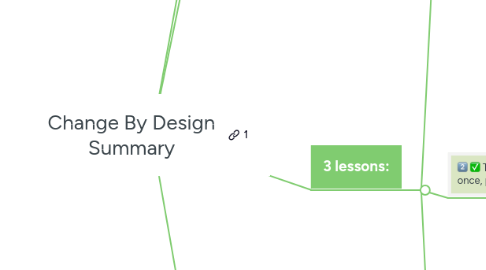
1. 1-Sentence-Summary:
1.1. Change By Design makes you a better problem solver at every aspect of life by outlining the design thinking process that companies can use to innovate and improve.
2. Favorite quote from the author:
2.1. "To harvest the power of design thinking, individuals, teams, and whole organizations have to cultivate optimism." - Tim Brown
3. 3 lessons:
3.1. Design thinking requires that you bring together the inspiration, ideation, and implementation phases of a project.
3.1.1. When building a product, go through different phases multiple times.
3.1.1.1. Instead of seeing them as separate and individual, look at all three together.
3.1.2. Begin with the inspiration phase.
3.1.2.1. This starts with thinking.
3.1.2.2. It’s that moment in the shower when the lightning bolt hits and you begin considering the solution and its opportunities.
3.1.3. Next comes the ideation part of the journey, in which you look more to testing and developing the idea to make it even better.
3.1.4. Implementation is the last step
3.1.4.1. This is when you take your final product and introduce it to the world.
3.1.5. Although the initial thought is to move smoothly through one phase at a time, in reality, no project does that.
3.1.5.1. Most go through each part multiple times even!
3.1.5.2. This is why design thinking is so powerful because it accounts for this from the beginning.
3.1.6. To make sure to integrate all components, keep feasibility, viability, and desirability in mind at each step.
3.1.6.1. The Nintendo Wii is a good example of this. It was feasible and viable because it worked well, and it’s immersive experience made customers desire it.
3.2. To get better at utilizing each step all at once, prototype as early as possible.
3.2.1. We tend to spend too long in the planning phase
3.2.1.1. It may take years for some projects to get to prototyping
3.2.2. Thinking is important, but do it while building your model
3.2.2.1. It makes getting results for what works and what doesn’t a whole lot faster.
3.2.2.2. When you build first and think as you go, you get more ideas for how to improve the thing as you go.
3.2.2.3. Many limitations and opportunities are hidden until you can actually see a mock-up of the product in real life.
3.2.2.4. Start prototyping from the start
3.2.3. It might look simple and ugly at first, but the benefits are worth it.
3.2.3.1. The initial prototype of Apple’s first mouse, for example, was only a plastic butter dish and the ball from a roll-on deodorant.
3.2.4. You need to find out how people will use your idea once you have your prototype, so begin testing early.
3.2.4.1. This will let you know what people will try doing with it, which will help you see new opportunities.
3.2.4.2. It will also tell you if it will even work
3.2.5. But the main reason testing early like this is so powerful is that it perfectly incorporates all three aspects of the design process at once.
3.2.5.1. You get inspired with new ideas from seeing a mock-up.
3.2.5.2. Ideation happens from the testing itself.
3.2.5.3. And you get to see if it’s even viable by practicing implementation.
3.3. Make sure to involve stories at every stage to help get your idea to stick with people.
3.3.1. We all enjoy a good adventure in a movie or book
3.3.1.1. This is part of human nature and something you need to utilize when working with ideas.
3.3.2. If you want to become a good design thinker, help users relate to your product with stories.
3.3.2.1. The best way to do this is to look at the steps you took to make it and how customers will use it throughout its lifetime.
3.3.3. Even from the very beginning, involve the customer.
3.3.3.1. Prototyping is one way to do this
3.3.3.2. But sometimes it even works to share your process of coming up with the idea in the first place, or the origins of the product.
3.3.4. One company put a code on every piece of clothing it sold.
3.3.4.1. Buyers could use this to track the wool inside a jacket to its beginnings.
3.3.4.2. Even all the way to the very farm that the sheep are taken care of!
3.3.5. Another example is what would become the predecessor of GPS systems.
3.3.5.1. The company that built the product shared a story of a sailor to help customers relate to it.
3.3.5.2. They talked about each problem he had along his journey and identified the features of the product as the solutions to the obstacles.
